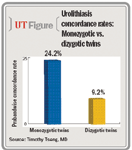Article
Genetic factors play important role in urolithiasis
Findings from a study determining prevalence and concordance rates for urolithiasis in a large twin population point to a major role of genetic factors in determining the risk of stone disease.

The study was based on data collected in the Danish Twin Registry and included a total of 18,122 patients (9,061 twin pairs) representing monozygotic and dizygotic twin pairs, males and females. In this population, the prevalence of urolithiasis was 3.7% overall, similar in monozygotic and dizygotic twins (3.8% and 3.7%, respectively), but significantly higher among men than women (4.9% vs. 2.9%).
Concordance higher in monozygotic twins
"Our findings on overall urolithiasis prevalence and the gender-related difference in prevalence rate are consistent with previous data," said co-author Timothy Tseng, MD, who was an endourology and laparoscopy fellow at the University of California, San Francisco working with first author Marshall Stoller, MD, when the study was conducted. "However, the similarity in concordance ratios regardless of gender suggests heritability may be similar in males and females, and the consistent significantly higher concordance rates in the monozygotic versus dizygotic twin pairs suggest a high level of genetic influence for stone disease.

Previous research investigating the genetic component of urolithiasis in a twin population consists of a single study that included only 381 twin pairs, all of which were males. Aiming to explore this topic in a larger and broader population base, Dr. Tseng and co-authors, including Kaare Christensen, MD, PhD, of the University of Southern Denmark, Odense, took advantage of data available in the Danish Twin Registry. The registry includes self-reported information on kidney stone disease based on responses to the question, "Did a doctor ever tell you that you have or had kidney stones?" that was included in multiple periodically administered surveys.
"Self-report of kidney stones has been previously validated as being highly reliable due to the severe nature of symptomatic kidney stones. It is unfortunate that information on stone type and metabolic analysis are not available with this study design," Dr. Tseng noted.
Within the study population, 44% of the 9,061 twin pairs were monozygotic and 42% of all subjects were males. The data analyses also showed that the cumulative prevalence of urolithiasis increased with increasing age.





